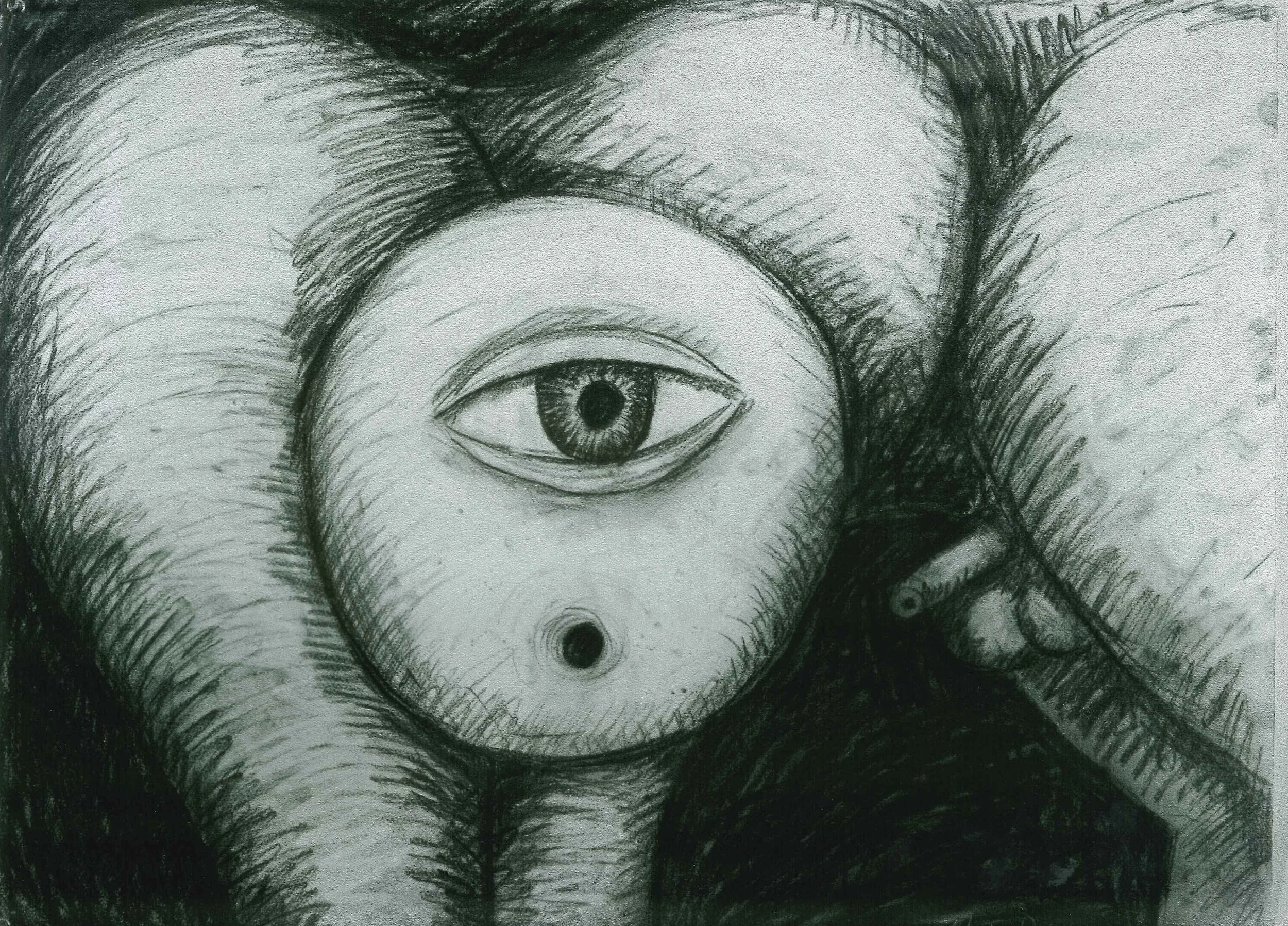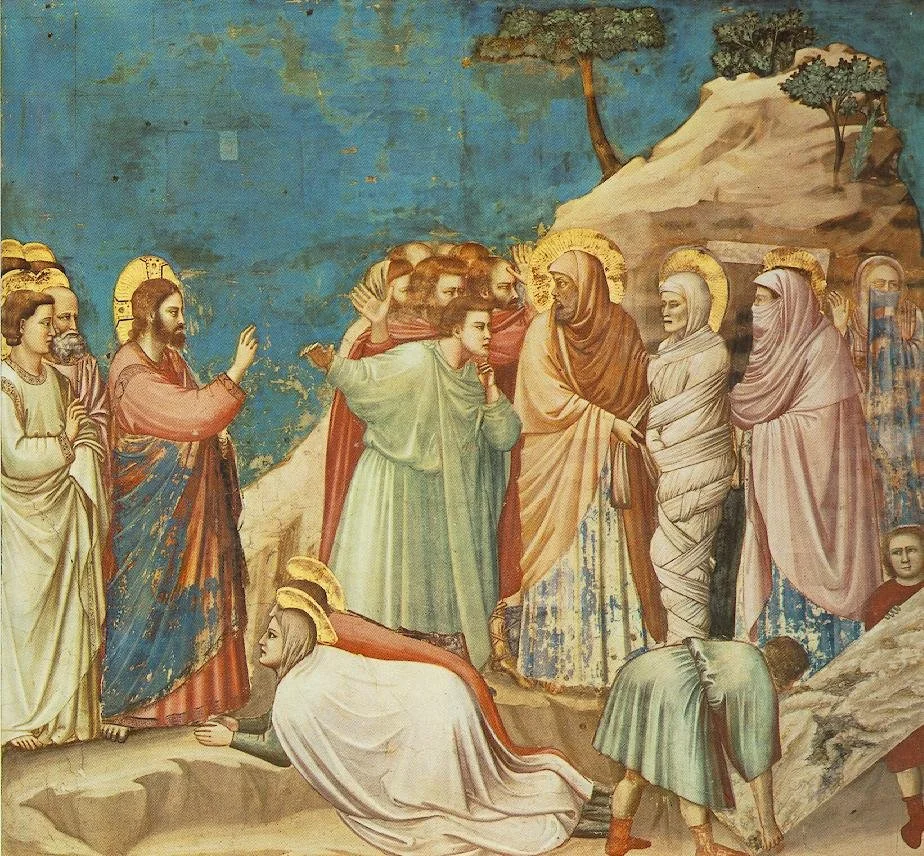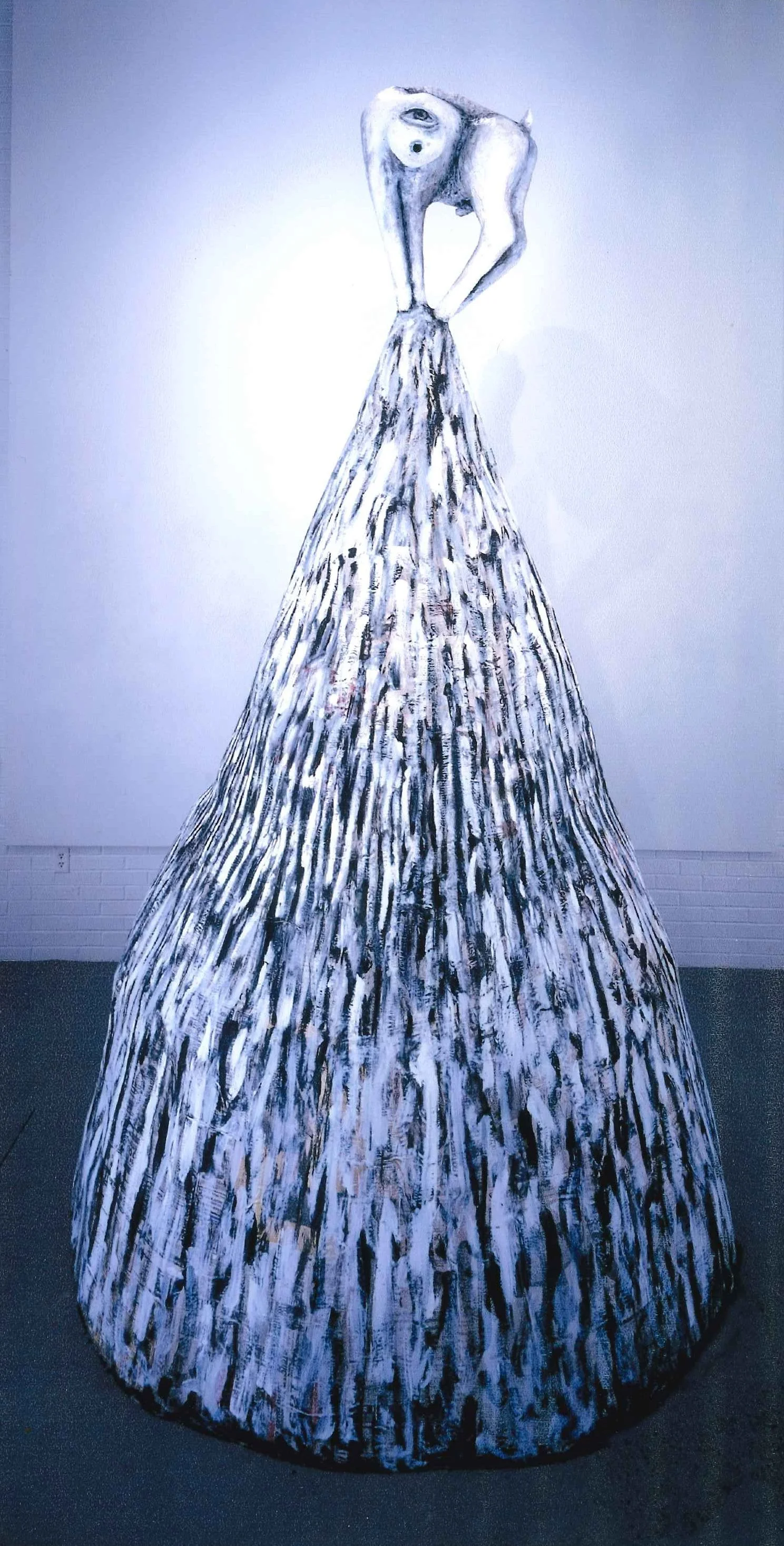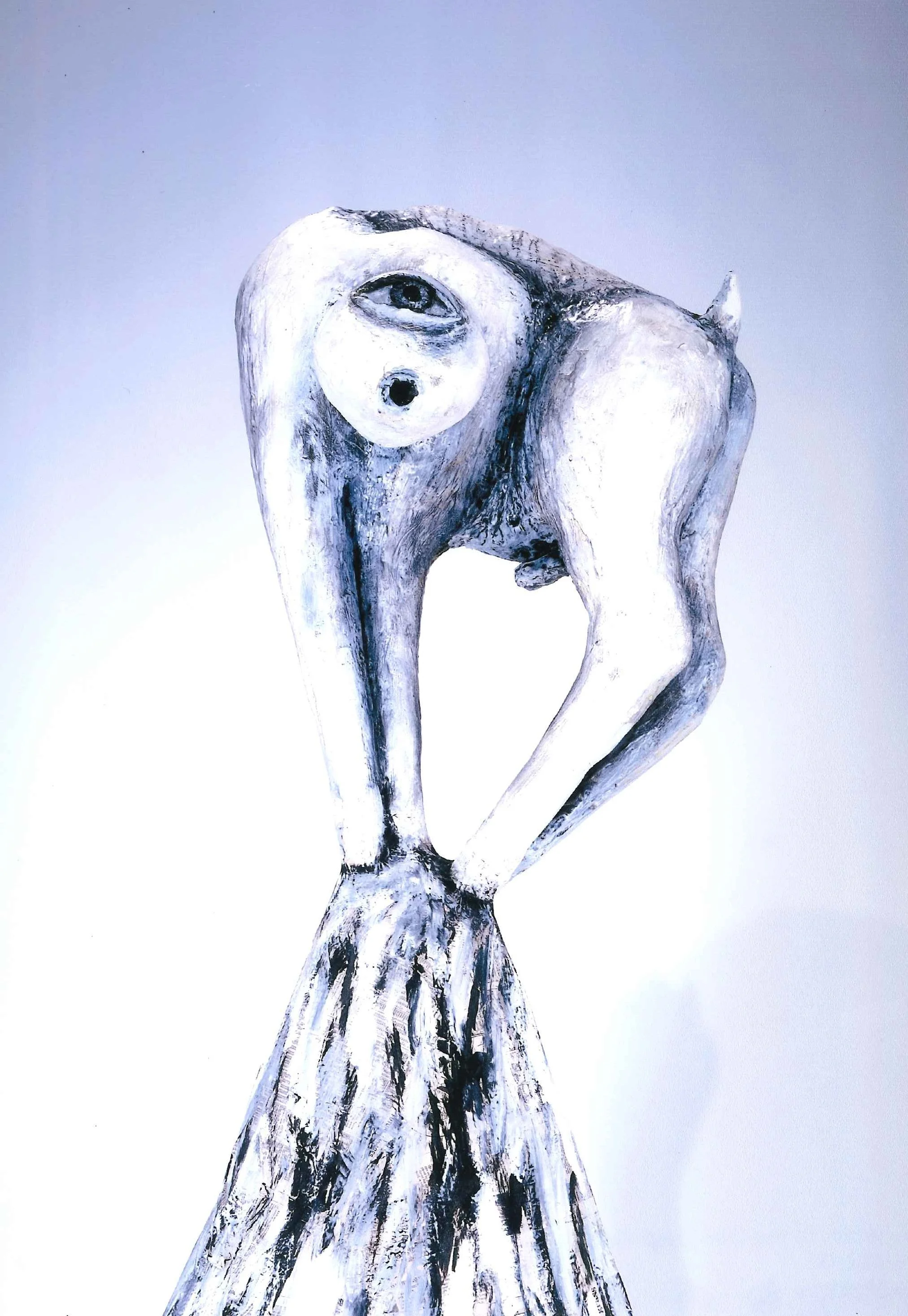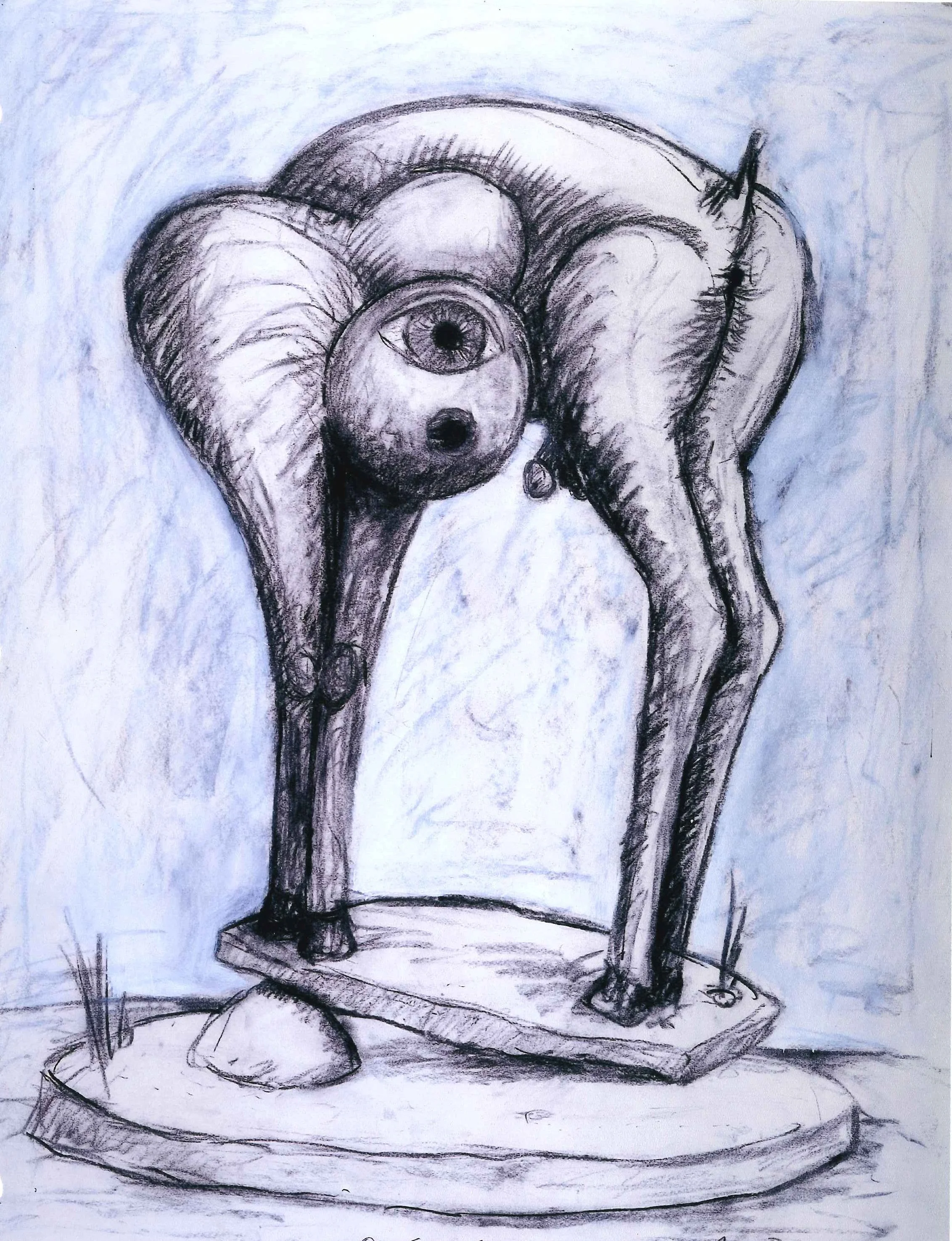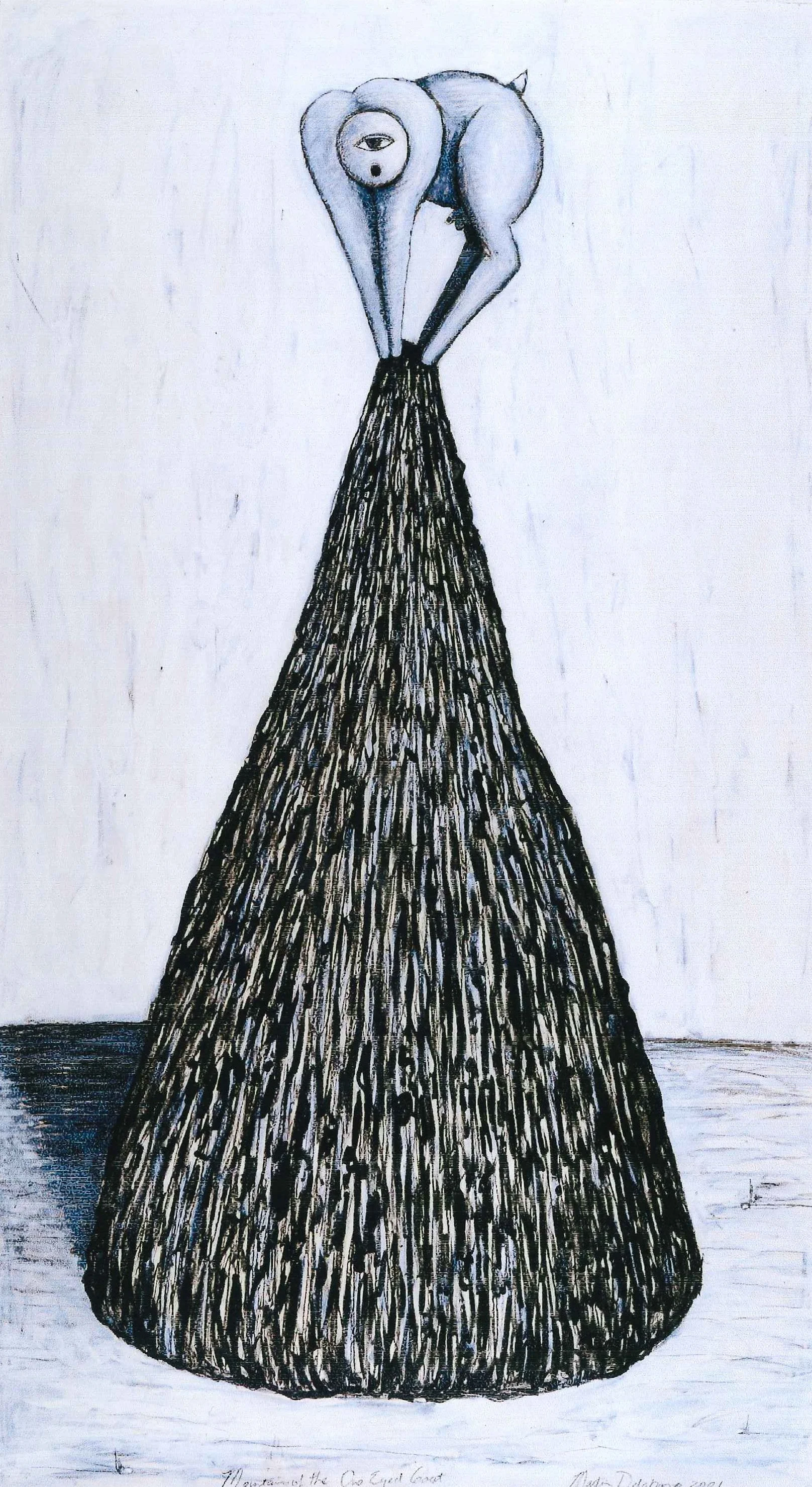Mountain of the One Eyed Goat
Before the Fall: The Mountain of the One-Eyed Goat
And he shall set the sheep on his right hand, but the goats on the left. 1
Inter oves locum praesta
Et ab haedis me sequestra
Statuens in parte dextra. 2
The high hills are a refuge for the wild goats. . . . 3
The mountain is roughly conical. The mountain is not quite as Giotto rendered mountains, as in the background in The Miracle of the Spring in the fresco cycle in the Church of San Francisco at Assisi, Giotto di Bondonenor quite as Andrea Mantegna rendered mountains, as in The Agony in the Garden in the collection of the National Gallery, London. Nor again is Delabano’s mountain like the mountains in the background of Leonardo’s The Virgin and Child With St. Anne, in the Louvre.
In the charcoal and acrylic on paper study Untitled [2], the precarious balance of the goat is suggested by the goat’s stance on a flat rock, propped at the left by an approximately hemispherical stone, and resting on a larger flat rock. Both in the large charcoal and acrylic drawing Untitled [4], and in the sculpture The Mountain of the One-Eyed Goat, the device of the precariously balanced flat rock is absent, with the locus of precarious balance shifted to the closely spaced feet of the goat itself at the point of the pinnacle. Indeed, the conical convergence of the legs of the goat to the closely spaced feet are formally the inverse of the conical form of the mountain; the forms of the mountain and the legs converging together suggest the center of an hourglass. This nexus of spatial convergence suggests a correlative nexus of temporal convergence, analogous to Nietzsche’s notion of the Augenblick: between past and future, between retention and protention, the goat is poised at the moment of the Now. 8 The handwritten note in the mixed media study Untitled [3] has:
Myopic Views
precarious balance
Constant Focus to avoid the fall.
Myopia, as “lacking foresight or discernment,” is analogous to a failure of anagogical interpretation, an inability to discern an overarching consequence. Given this failure, the goat’s focus must be constantly vigilant to maintain its precarious balance to avoid the fall. A precarious balance is one poised in the transient moment of the Now between stasis and dynamis, equilibrium as a constant state and precipitate falling. Neither static or movement, a precarious balance is outside the duration of equilibrium and the transience of falling: the moment of precarious balance is outside of quotidian temporality, a perduring Now. This moment of precarious balance, like Nietzsche’s Augenblick, is a decisive moment for being, and thus a moment for the determination of authenticity.
9 The goat’s single, myopic eye is a synecdoche, the eye as part being equivalent for goat as whole. As Hegel urges, “art makes every one of its productions into a thousand-eyed Argus, whereby the inner soul and spirit is seen at every point.” 10 Thus Rilke concludes “Archaic Torso of Apollo” with: for here there is no place that does not see you. You must change your life. 11
David Newman
— Gallery Director and Curator’s Essay
As with these antecedent representations of mountains, Delabano’s mountain is an invention, a mountain more of the mind than of geology. 4 Yet Delabano’s mountain is not less a mountain for being an invented mountain, a projection of the idea of mountain into three dimensions, abstracted into the rudimentary form signifying mountain. Delabano’s mountain is a high place above the plain of the gallery floor. With black and white scumbled paint streaking down the side, the mountain is a peak with snow or ice, a slippery slope. The goat atop the steeply sloped pinnacle is inaccessible, visible but beyond one’s reach, beyond one’s grasp. Or more precisely, the goat is within one’s visible access, but beyond the reach of one’s touch, thus valorizing the distal mode of visual perception while vitiating the proximal sensory mode of perception by touch. The mountain functions as a base in elevating the goat, while denying its status as a base in being an element of the sculpture itself.
As embodied and thus visible, the goat is also a representation of a biological ground of vision: the “flesh,” as Merleau-Ponty terms it, in which the world folds back onto itself in seeing itself. 5 The vision of the goat subsists in a central, single eye: a cyclops-goat. The handwritten note, and a printed text, in the mixed media study Untitled [3] suggests that the goat not only has one eye, but that the eye is myopic. Thus the printed text in Untitled [3], giving a dictionary definition of myopia:
Myopic 1. A condition in which the visual images come to a focus in front of the retina of the eye resulting esp. in defective vision of distant objects.
2. Deficiency of foresight or discernment. myopic – myopically.
The conical form of the mountain is analogous to the cone of vision, of the path of light rays entering the eye. The Mountain of the One-Eyed Goat is, approximately, a three-dimensional analogue for the diagram for Descartes’ Dioptric of visual perception entailing a geometrical projection onto the retina. In the diagram in the Dioptric, a small human figure is placed behind the eyeball, observing the retinal image. In Delabano’s sculpture, the goat’s nearly spherical head functions formally as the eyeball, while the goat as a whole functions as the spectator. The spectator behind the retina is a consequence of Descartes’ radical separation of mind and body, a separation that falls to the inherent infinite regress it entails: the implied viewer behind the retina of the viewer behind the retina. 6 The goat atop the mountain is a kosmotheros, a seer beholding all that is, the viewpoint taken by Leon Battista Alberti’s emblem of a winged eye, 7 soaring above and surveying all that is. Seeing all that is-but the eye is flawed, myopic, “lacking foresight or discernment.”
Works in the Exhibition
1 Mountain of the One-Eyed Goat Poster charcoal on paper 30 x 22
2 Untitled charcoal, acrylic on paper 32 x 25
3 Untitled charcoal, acrylic, graphite, metal leaf, collage, inkjet prints on paper 32 x 85.5
4 Untitled charcoal, acrylic on paper 85.5 x 48
5 Untitled charcoal on paper 22 x 30
6 Mountain of the One-Eyed Goat mixed media 140 x 80 x 80
Endnotes
1. Matthew 25:33. return
2. The Missal, Order of Mass for the Dead ‘Sequentia’ 22: “Among the sheep set me a place / and separate me from the goats, / standing me on the right-hand side.” return
3. Psalms 104:26. return
4. Invention may be aided, as Cennino Cennini suggests in chapter LXXXVIII of Il Libro del’ Arte, by working from “large stones, rugged, and not cleaned up.” The Craftsman’s Handbook, Il Libro ell’ Arte, Cennino d’Andrea Cennini, trans. Daniel V. Thompson, Jr. (New York: Dover, 1960 [reprint of the 1933 Yale University Press edition]), p. 57. return
5. Maurice Merleau-Ponty, The Visible and the Invisible, trans. Alphonso Lingis. (Evanston: Northwestern University Press, 1968), p. 127 et passim. return
6. See James Schmidt, Maurice Merleau-Ponty: Between Phenomenology and Structuralism (New York: St. Martin’s, 1985), p. 99. return
7. Alberti’s emblem of a winged eye is found verso on the portrait medallion of Alberti by Matteo de’ Pasti, 1446-1450. George Francis Hill, A Corpus of Italian Medals, vol. 2 (London: British Museum, 1930); fig. 21 in Joan Gadol, Leon Battista Alberti: Universal Man of the Early Renaissance (Chicago: University of Chicago Press, 1969), p. 69. return
8. Fredreich Neitzsche, The Gay Science, trans. Walter Kaufman (New York: Vintage, 1975) par. 109; cf. Thus Spake Zarathustra, in ed. and trans. Walter Kaufman, The Portable Nietzsche (New York: Vintage, 1958). return
9. For the connection of the Augenblick with Heidegger’s conception of authenticity [Eigentlichkeit] as the moment of decisive manifestation of Being, see Michael E. Zimmerman, “Appendix: Authenticity in Light of Heidegger’s Gesamtausgabe,” Eclipse of the Self: The Development of Heidegger’s Sense of Authenticity (Athens: Ohio University Press, 1981), pp. 277-300. return
10. Georg Wilhelm Freidrich Hegel, Aesthetics: Lectures on the Fine Arts, 2 vols. Trans. T. M. Knox. (Oxford: Oxford University Press, 1975), I., 153-154. return
11. Rainer Maria Rilke, Archaïscher Torso Apollos. return

